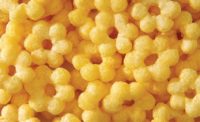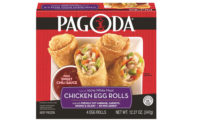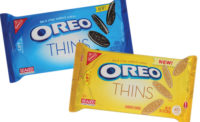Balancing tradition and better-for-you innovation in extruded snacks: State of the Industry 2016
Puffed and extruded snacks neatly balance strong-performing traditional approaches and better-for-you innovation.


courtesy of Utz Quality Foods

courtesy of PepsiCo

courtesy of Simply 7 Snacks

courtesy of I Heart Foods Corp

courtesy of Buhler Group

courtesy of Bunge

PUFFED & EXTRUDED SNACKS Sales

PUFFED & EXTRUDED SNACKS Sales









The puffed and extruded snack segment combines the best elements of tradition and forward-thinking better-for-you innovation. On the traditional side, a product like Cheetos continues to dominate. Meanwhile, snack producers across the industry continue to ramp-up puffed snacks positioned as better-for-you alternatives. Together, these product categories combine to position the puffed and extruded snack segment as a leader in salty snacks today.
Overview | Chips | Puffed/Extruded Snacks | Popcorn | Snack Mixes & Nuts | Tortilla Chips | Pretzels | Frozen Snacks | Crackers
“The extruded snack market still shows strong growth,” says Tom Barber, vice president of process engineering, Buhler Aeroglide, a division of Buhler Group, Cary, NC. “Several factors likely account for this trend.” Among those factors, he says, is the overall desire among consumers of all ages for convenience, as well as the fact that snacking frequency has increased significantly in recent years, a trend driven mostly by millennials.
Additionally, extruded snacks like popped chips and veggie straws appeal to health-minded shoppers who are stepping away from fried snacks. “Since snacks are no longer just an occasional treat and are now replacing traditional meals, consumers expect their snacks to offer balanced nutrition and quality ingredients, while still tasting good,” says Dallas Anthony, general manager and vice president of extrusion and rice, Bunge North America, St. Louis. “Snack-making demands creativity, attention to flavor and texture, and sophisticated technology and processing. With the ability to incorporate trending grains, fruits, vegetables and other ingredients into trending flavors, extruded snacks meet these demands.”
Market data
According to data from IRI, Chicago, extruded snacks had a great year. Cheese snacks as a category was up 5.96 percent in dollar sales for the 52 weeks ending April 17, 2016, garnering $2.0 billion in sales. PepsiCo, owner of Frito-Lay, was up 6.34 percent in dollar sales to $1.7 billion thanks to strong sales from its segment-dominating Cheetos products. Utz Quality Foods saw its cheese snacks grow by 13.38 percent in dollar sales for the year.
Frito-Lay Cheetos are the flagship of cheese snacks, and several products performed well for the 52-week period, per IRI:
- Cheetos up 6.56 percent to $1.5 billion
- Cheetos Simply Cheese up 14.87 percent to $28.8 million
- Cheetos Sweetos up 96.98 percent to $9.8 million
PepsiCo also owns the No. 2 cheese snack brand, Chester’s, which was up 4.48 percent in dollar sales to $108.0 million.
Utz Quality Foods saw its Utz brand of cheese snacks grow by 16.03 percent in dollar sales for the year, taking in $48.4 million.
The “other salted snacks (no nuts)” segment of the salty snacks category also includes a good level of puffed and extruded snacks, and saw growth of 5.52 percent in dollar sales to $3.9 billion. Pork rinds also had a good year, growing 8.44 percent in dollar sales to reach $340.8 million. PepsiCo Frito-Lay brand Baken-Ets leads the pork rinds segment, up 32.57 percent to $77.0 million.
Looking back
While traditional products like Cheetos continue to dominate this segment, a strong contingency of incremental growth has been in better-for-you—a trend that even iconic PepsiCo brand Frito-Lay sought to recognize with its Cheetos Simply Cheese line, a clean-label effort that is seeing growth, up 14.87 percent in dollar sales to $28.8 million.
Calbee North America, owner of the Harvest Snaps brand of puffed veggie snacks, grew by 52.90 percent in dollar sales for the year to $79.9 million.
The Hain Celestial Group has a strong presence in puffed and extruded snacks, and its Sensible Portions brand cheese snacks grew by 803.70 percent to $7.4 million in sales.
This strong growth of better-for-you puffed and extruded snack options reflects a growing segment of salty snack consumers looking for new options, often made with an increasingly diverse set of ingredients.
“The extruded snack market is growing, but trending away from empty calorie solutions into more calorically and nutritionally dense options,” says Jon Baner, senior technical manager of extrusion, PacMoore Products, Inc., Hammond, IN. “We continue to see strong interest in pulse and legume ingredients, as well as ancient grains, with a focus on clean-label solutions.” The company’s latest additions to its Gridley, IL facility include a pilot twin-screw extruder, as well as staff support for customer product development projects.
Angie’s Artisan Treats has offered ancient grain snacks via its BoomChickaPuff line, made with quinoa and sorghum.
Healthy Food Ingredients, Fargo, ND, offers AncientGrisps, an extruded crisp that’s custom milled from a blend of ancient grains. “We also now offer Suntava Purple Corn in additional processed forms,” says Regina Bertoldo, food scientist for the company. She notes that many of these products are organic, non-GMO and allergen-free.
“Extrusion is a way to delineate a brand and incorporate creativity and flexibility into product lines,” says Anthony. “Custom die molds give companies the opportunity to create novel shapes that will distinguish them on the shelf. Extrusions can also be customized through a variety of finishing options, which allow brands to develop a range of colors and flavors.” Bunge’s pellet extrusion allows for even greater production variation on the ingredient side—from vegetables and legumes to more-unique ingredients like red pepper, kale, zucchini and chia seeds.
Anthony sees great opportunity to increase health appeal for consumers. “Air-popped extrusions made with healthier ingredients are on-trend right now,” he says. “These deliver a healthier snack option that still offers the appealing crunch of traditional chips and other, more-caloric snacks.”
Looking forward
Though extruded snacks represent a growth opportunity for manufacturers and brands, they don’t come without their share of challenges—especially where the health trend is concerned.
A recent survey by Bunge revealed that nearly half of foodservice companies and food manufacturers will be prioritizing the use of natural flavors and additives in 2016.
But when it comes to extrusions, this is a challenge, says Viviana Bermudez, director of research and development, Bunge Milling. “Heat can cause natural colors and flavors, which are sensitive to heat, to break down.” To address this challenge, Bunge has invested in this area, and now uses ingredients like turmeric, annatto color and others to provide vibrant colors and a clean label.
Natural ingredients can also present challenges when it comes to taste. “Consumers expect snacks to taste good and be at least somewhat indulgent, while being free from certain ingredients and fortified with others,” explains Baner. But this is a challenge for extruded options, since proteins and ancient grains may provide flavor profiles that fall short of consumer expectations. “This is often a process of trial-and-error and refinement, but it is a great opportunity for the best food processors,” he says, adding that topical flavors and seasonings can mask some of these off-notes.
Trends going forward will center on ethnic and international flavors, notes Barber, as well as the role of pulses—beans, chickpeas and lentils—in extruded snacks. “Pulses provide the perfect raw material for extruded snacks,” he says, “offering fiber and an alternative to animal protein.”
In the end, it’s all about creating the right set of options to cultivate widespread appeal.
Overview | Chips | Puffed/Extruded Snacks | Popcorn | Snack Mixes & Nuts | Tortilla Chips | Pretzels | Frozen Snacks | Crackers
Looking for a reprint of this article?
From high-res PDFs to custom plaques, order your copy today!














